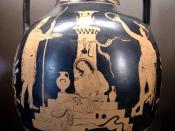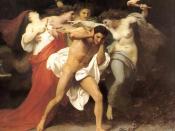Aeschylus' use of darkness and light as a consistent image in the Oresteia depicts a progression from evil to goodness, disorder to order. In the Oresteia, there exists a situation among mortals which has gotten out of control; a cycle of death has arisen in the house of Atreus. There also exists a divine disorder within the story which, as the situation of the mortals, must be brought to resolution: the Furies, an older generation of gods, are in conflict with the younger Olympian gods because they have been refused their ancient right to avenge murders between members of the same family. The Oresteia presents two parallel conflicts, both of which must be resolved if harmony is ever to be desired again. As one can expect, these conflicts eventually do find their resolutions, and the images of darkness and light accompany this progression, thereby emphasizing the movement from evil to good.
The use of darkness imagery first emerges in the Agamemnon. In this first play of the trilogy, the cycle of death which began with the murder and consumption of Thyestes' children continues with Clytaemestra's murder of Agamemnon and Cassandra. The darkness which is present in the beginning of the story is further magnified by the death of Agamemnon. This is illustrated when Clytaemestra says, "Thus he [Agamemnon] went down, and the life struggled out of him; and as he died he spattered me with the dark red and violent driven rain of bitter savored blood" (lines 1388-1390). Clytaemestra has evilly and maliciously murdered her own husband; thus the image of the dark blood. The darkness is representative of the evil which has permeated the house of Atreus, and which has persisted with this latest gruesome act of murder. Because darkness results from the death of Agamemnon, Aeschylus clearly...


